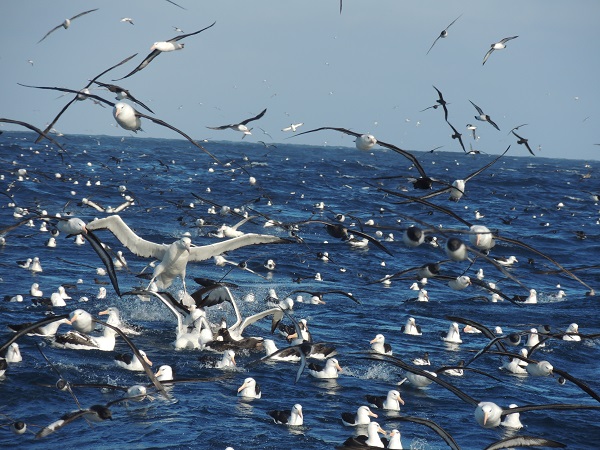 Albatrosses and petrels gather behind a fishing vessel; photograph by Nahuel Chavez
Albatrosses and petrels gather behind a fishing vessel; photograph by Nahuel Chavez
Note: Today is Day Six of “WADWEEK2024”, a series of seven daily posts to ACAP Latest News leading to World Albatross Day on 19 June, in support of this year’s theme of “Marine Protected Areas – Safeguarding our Oceans”.
From 1 October, a transformative shift will sweep across New Zealand’s pelagic longline fishing fleet. Fisheries New Zealand has unveiled new regulations designed to significantly reduce the accidental capture of seabirds, particularly its many species of albatrosses.
The new regulations are grounded in ACAP's Best Practice Advice, which identifies the most effective methods to reduce seabird bycatch in pelagic longline fisheries. ACAP recommends that fishers simultaneously implement three key measures: branch line weighting, night setting, and bird scaring lines. Alternatively, the use of an assessed hook-shielding device or underwater bait setting device is recommended.
Sebastián Jimenez, Co-convenor of ACAP’s Seabird Bycatch Working Group said the announcement from Fisheries New Zealand is warmly welcomed by the Agreement.
“These regulations are a significant step forward in protecting seabirds from the threats posed by bycatch. By adopting these proven measures, New Zealand is demonstrating global leadership in marine conservation."
These ACAP-endorsed measures, known as 'three out of three,' will replace the current rules, which require only two of the seabird mitigation measures to be implemented. This comprehensive approach ensures that New Zealand’s fishing practices align with the highest standards of seabird conservation.
Fisheries New Zealand’s Director of Fisheries Management, Emma Taylor says the new rules will strengthen protections for some of the nation’s most vulnerable seabirds and have come only months after the installation of electronic monitoring (EM) camera systems on 100% of New Zealand’s fishing fleet.
"We have systems to monitor the position of all commercial fishing vessels in real time, and fishers are legally required to report their catch and position to us electronically. Alongside this, onboard cameras provide independent verification of fishing activity, including accidental bycatch of protected species.”
ACAP Best Practice Advice for seabird bycatch mitigation, including its Factsheets are available at the website under, Resources, here.
18 June 2024

 English
English  Français
Français  Español
Español